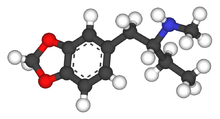

This article needs additional citations for verification. Please help improve this articlebyadding citations to reliable sources. Unsourced material may be challenged and removed.
Find sources: "MBDB" – news · newspapers · books · scholar · JSTOR (November 2013) (Learn how and when to remove this message) |
 | |

Chemical structure
| |
| Clinical data | |
|---|---|
| Other names | Methylbenzodioxolylbutanamine; N-Methyl-1,3-benzodioxolylbutanamine; MBDB; 3,4-Methylenedioxy-N-methyl-butanphenamine; MDMB |
| Legal status | |
| Legal status |
|
| Identifiers | |
| |
| CAS Number | |
| PubChem CID | |
| ChemSpider | |
| UNII | |
| KEGG | |
| CompTox Dashboard (EPA) | |
| Chemical and physical data | |
| Formula | C12H17NO2 |
| Molar mass | 207.273 g·mol−1 |
| 3D model (JSmol) | |
| Melting point | 156 °C (313 °F) |
| |
| |
| (verify) | |
1,3-Benzodioxolyl-N-methylbutanamine (N-methyl-1,3-benzodioxolylbutanamine, MBDB, 3,4-methylenedioxy-N-methyl-α-ethylphenylethylamine) is an entactogen of the phenethylamine chemical class. It is known by the street names Eden and Methyl-J.[1] MBDB is a ring substituted amphetamine and an analogueofMDMA. Like MDMA, it has a methylene dioxy substitution at the 3 and 4 position on the aromatic ring; this is perhaps the most distinctive feature that structurally define analogues of MDMA, in addition to their unique effects, and as a class they are often referred to as "entactogens" to differentiate between typical psychostimulant amphetamines that (as a general rule) are not ring substituted. MBDB differs from MDMA by having an ethyl group instead of a methyl group attached to the alpha carbon; all other parts are identical. Modification at the alpha carbon is uncommon for substituted amphetamines. It has IC50 values of 784 nM against 5-HT, 7825 nM against dopamine, and 1233 nM against norepinephrine.[citation needed] Its metabolism has been described in scientific literature.[2]
MBDB was first synthesized by pharmacologist and medicinal chemist David E. Nichols[citation needed] and later tested by Alexander Shulgin and described in his book, PiHKAL: A Chemical Love Story. MBDB's dosage, according to PiHKAL, is 180–210 mg; the proper dosage relative to body mass seems unknown. Its duration is 4–6 hours, with noticeable after-effects lasting for 1–3 hours.
MBDB was initially developed as a non-psychedelic entactogen. It has lower effects on the dopamine system in comparison to other entactogens such as MDMA.[citation needed] MBDB causes many mild, MDMA-like effects, in particular the lowering of social barriers and inhibitions, pronounced sense of empathy and compassion, mood lift, and mild euphoria, all of which are present.[citation needed] MBDB tends to produce less euphoria, psychedelia, and stimulation in comparison to MDMA.[citation needed]
Unlike MDMA, MBDB is not internationally scheduled under the United Nations Convention on Psychotropic Substances. The thirty-second meeting of the WHO Expert Committee on Drug Dependence (September 2000) evaluated MBDB and recommended against scheduling.[3] From the WHO Expert Committee assessment of MBDB:
MBDB is considered a Schedule 9 Prohibited substance in Australia under the Poisons Standard (October 2015).[4] A Schedule 9 substance is a substance which may be abused or misused, the manufacture, possession, sale or use of which should be prohibited by law except when required for medical or scientific research, or for analytical, teaching or training purposes with approval of Commonwealth and/or State or Territory Health Authorities.[4]
MBDB is included into Schedule 1 of the Controlled Substances Act.[5]
Sveriges riksdags health ministry Statens folkhälsoinstitut [sv] classified MBDB as "health hazard" under the act Lagen om förbud mot vissa hälsofarliga varor [sv] (translated Act on the Prohibition of Certain Goods Dangerous to Health) as of Feb 25, 1999, in their regulation SFS 1999:58 listed as "2-metylamino-1-(3,4-metylendioxifenyl)-butan (MBDB)", making it illegal to sell or possess.[6]
|
| |
|---|---|
| Phenylalkyl- amines (other than cathinones) |
|
| Cyclized phenyl- alkylamines |
|
| Cathinones |
|
| Tryptamines |
|
| Chemical classes |
|
|
| |
|---|---|
| Phenethylamines |
|
| Amphetamines |
|
| Phentermines |
|
| Cathinones |
|
| Phenylisobutylamines |
|
| Phenylalkylpyrrolidines |
|
| Catecholamines (and close relatives) |
|
| Miscellaneous |
|